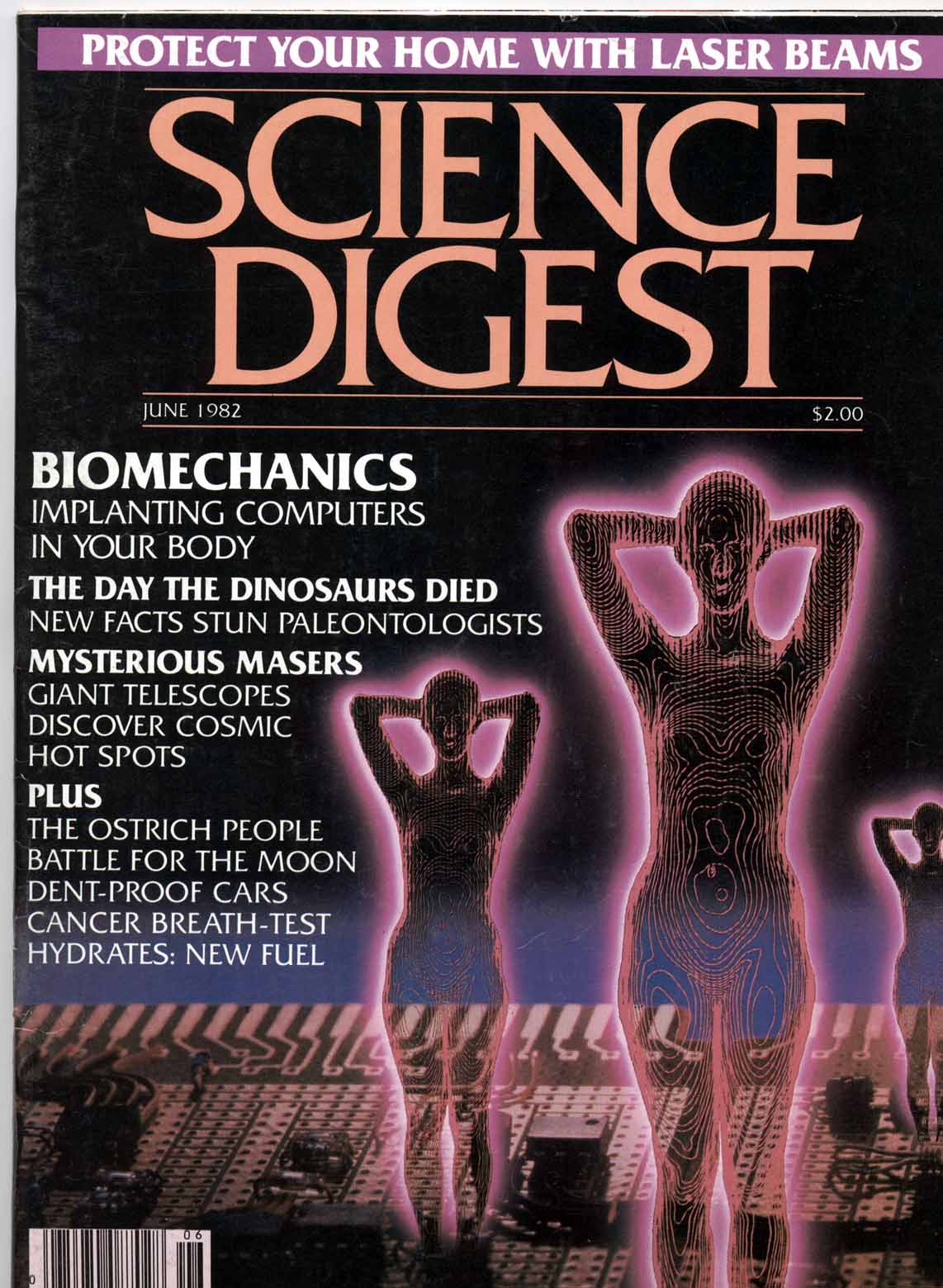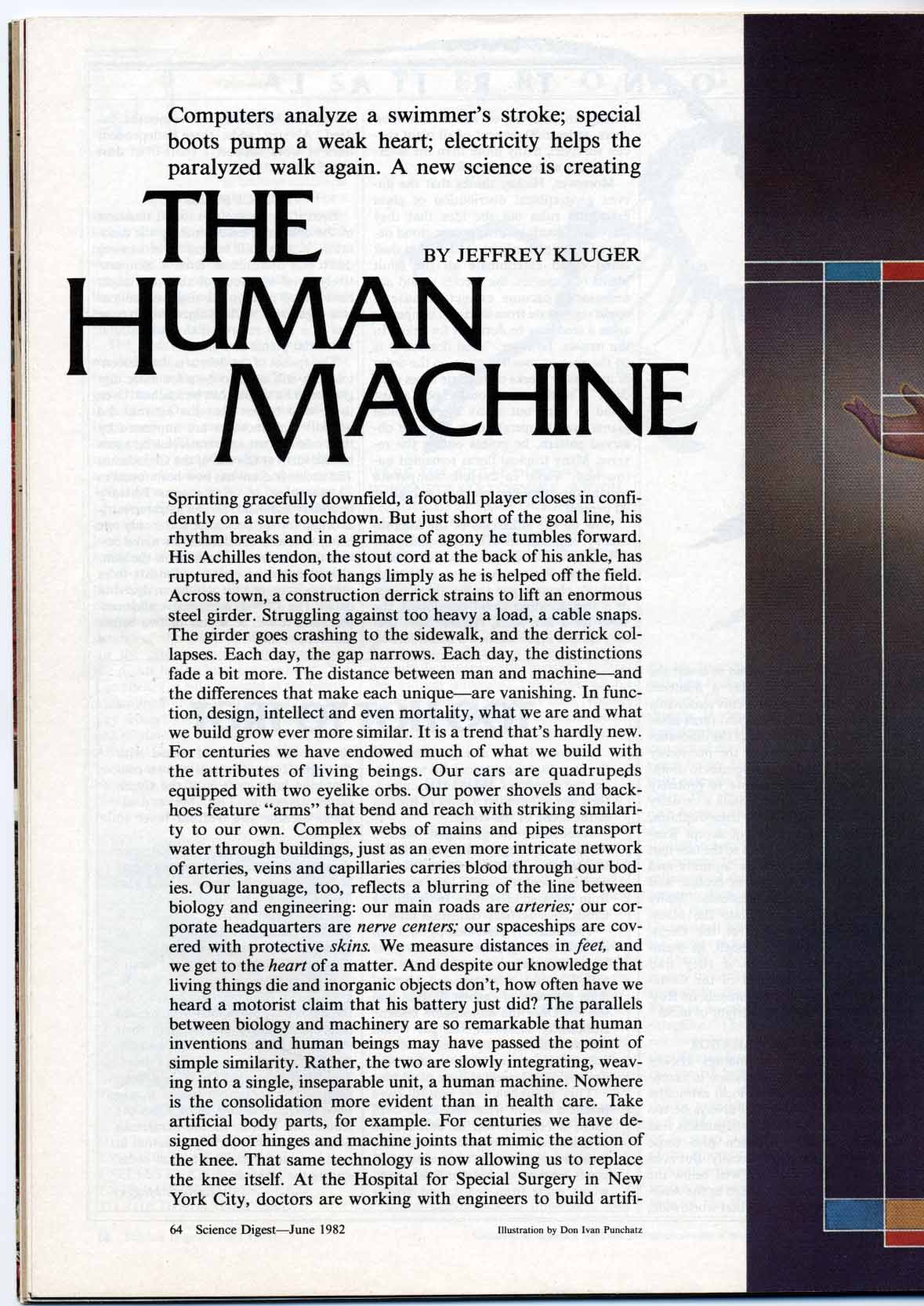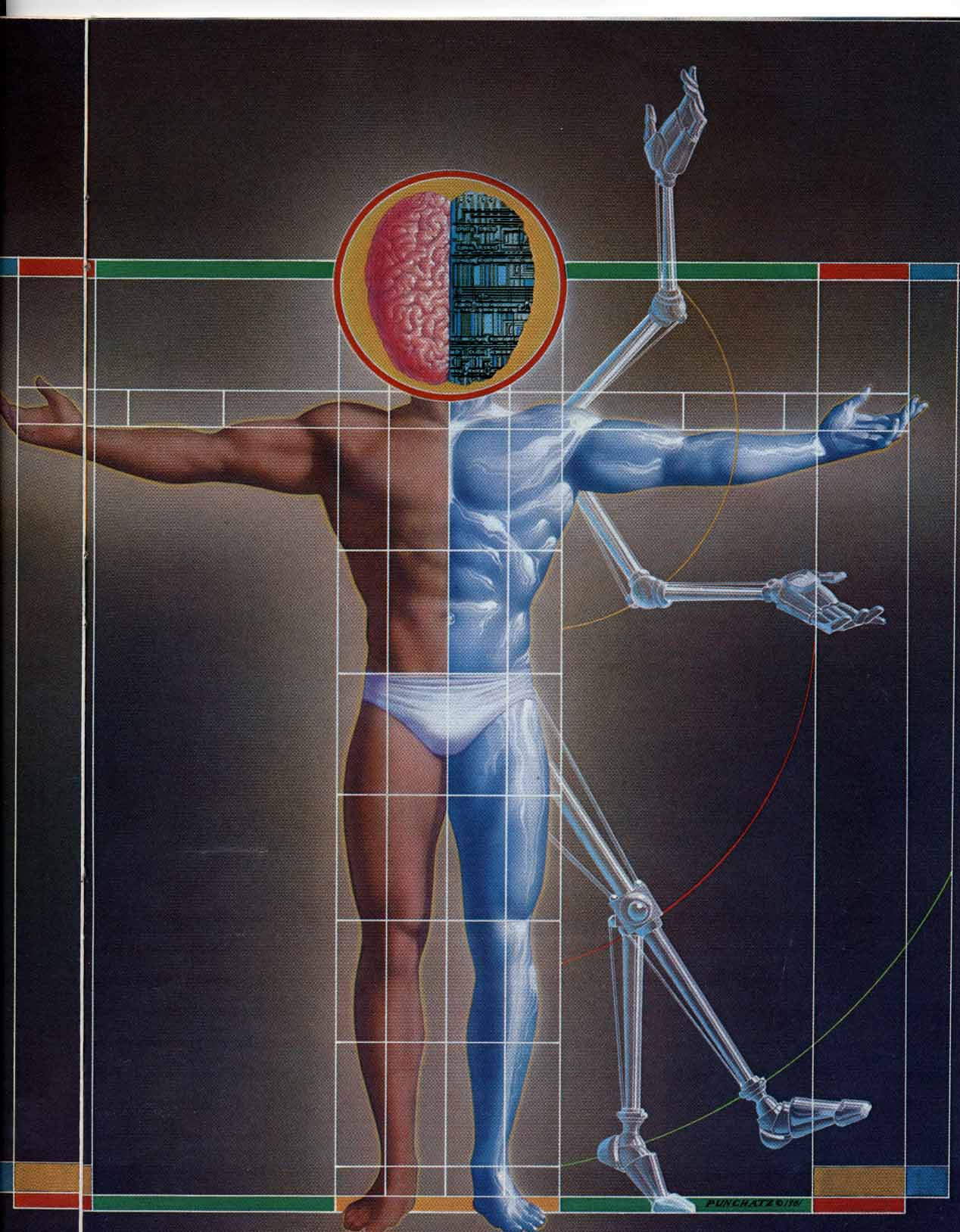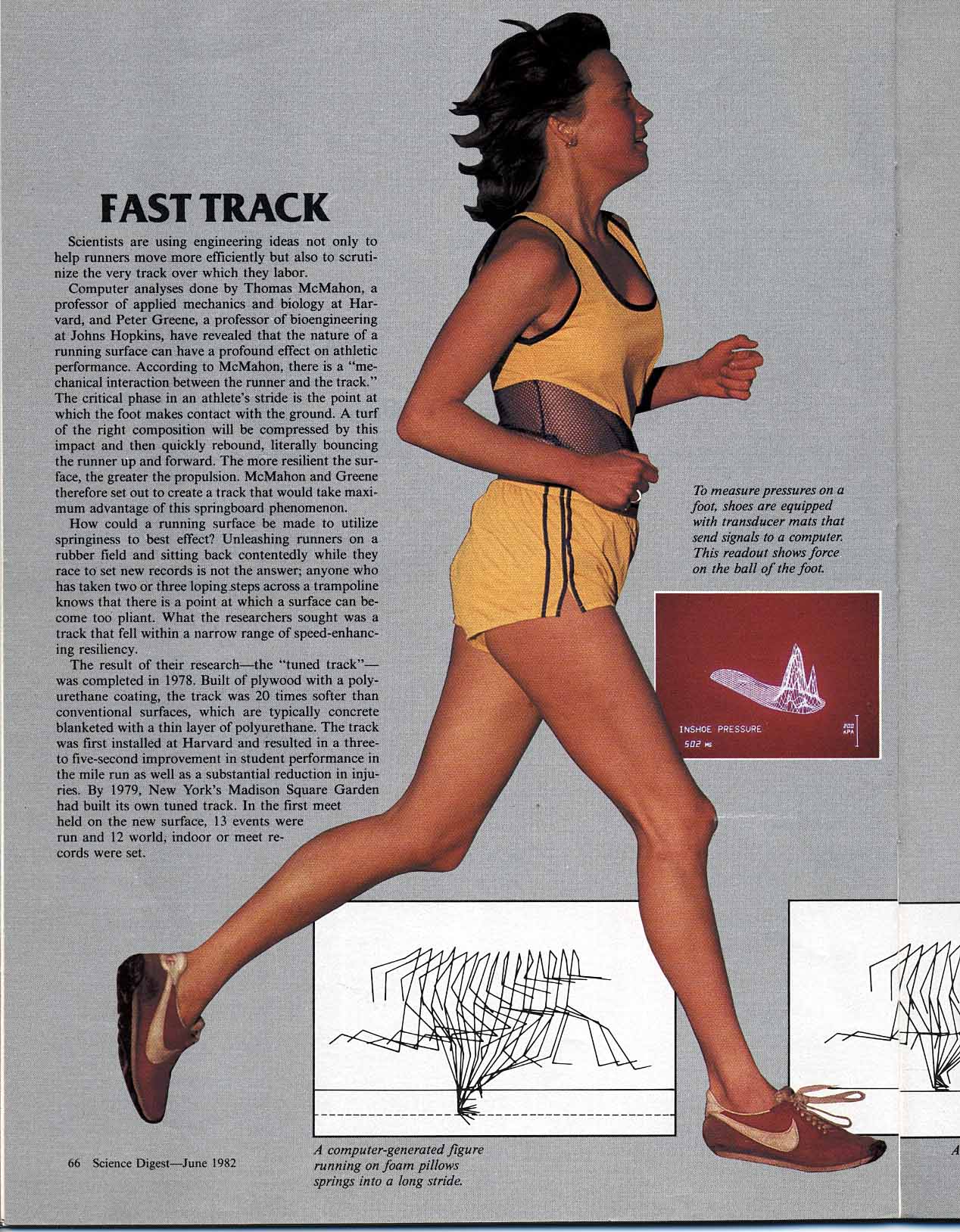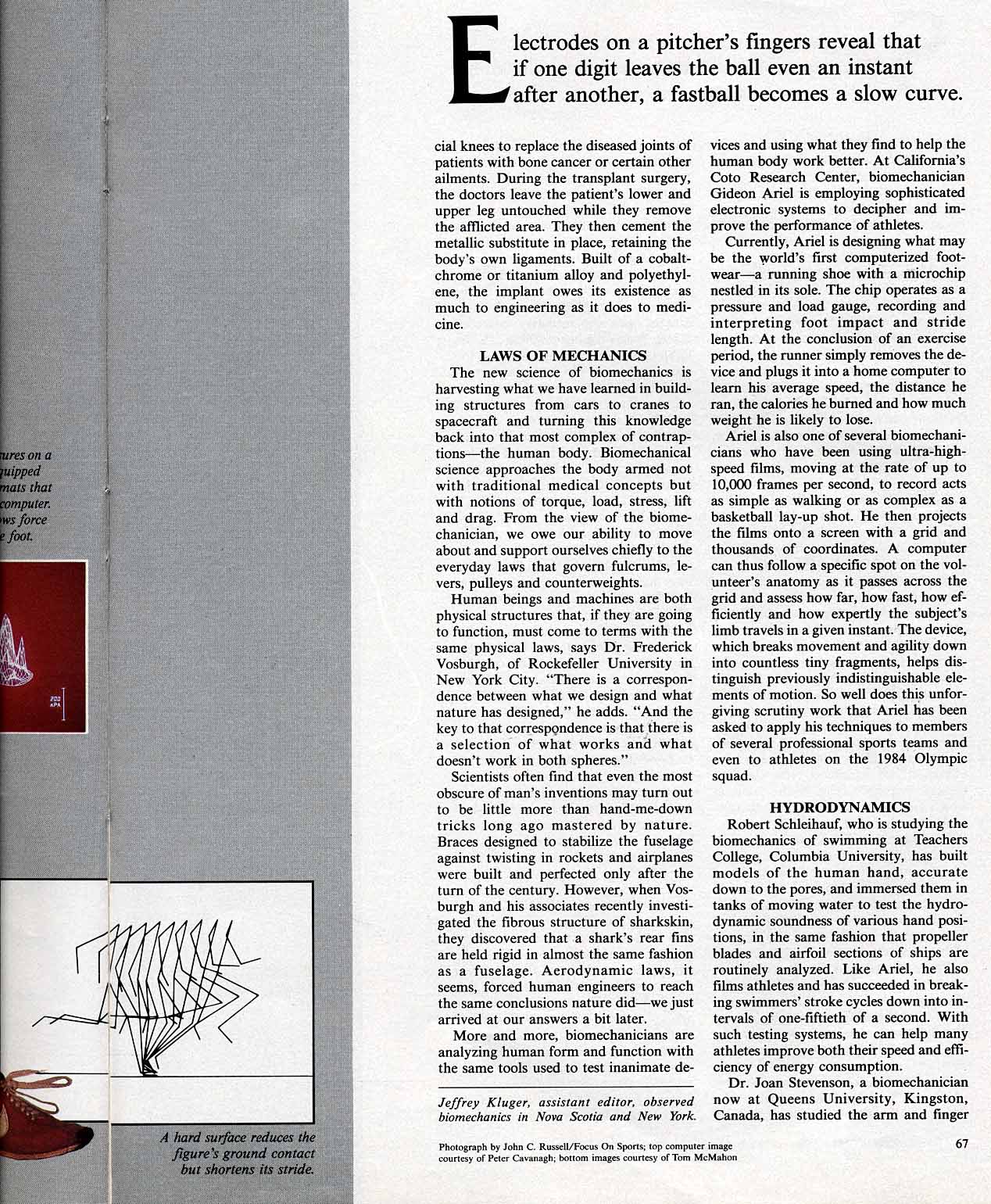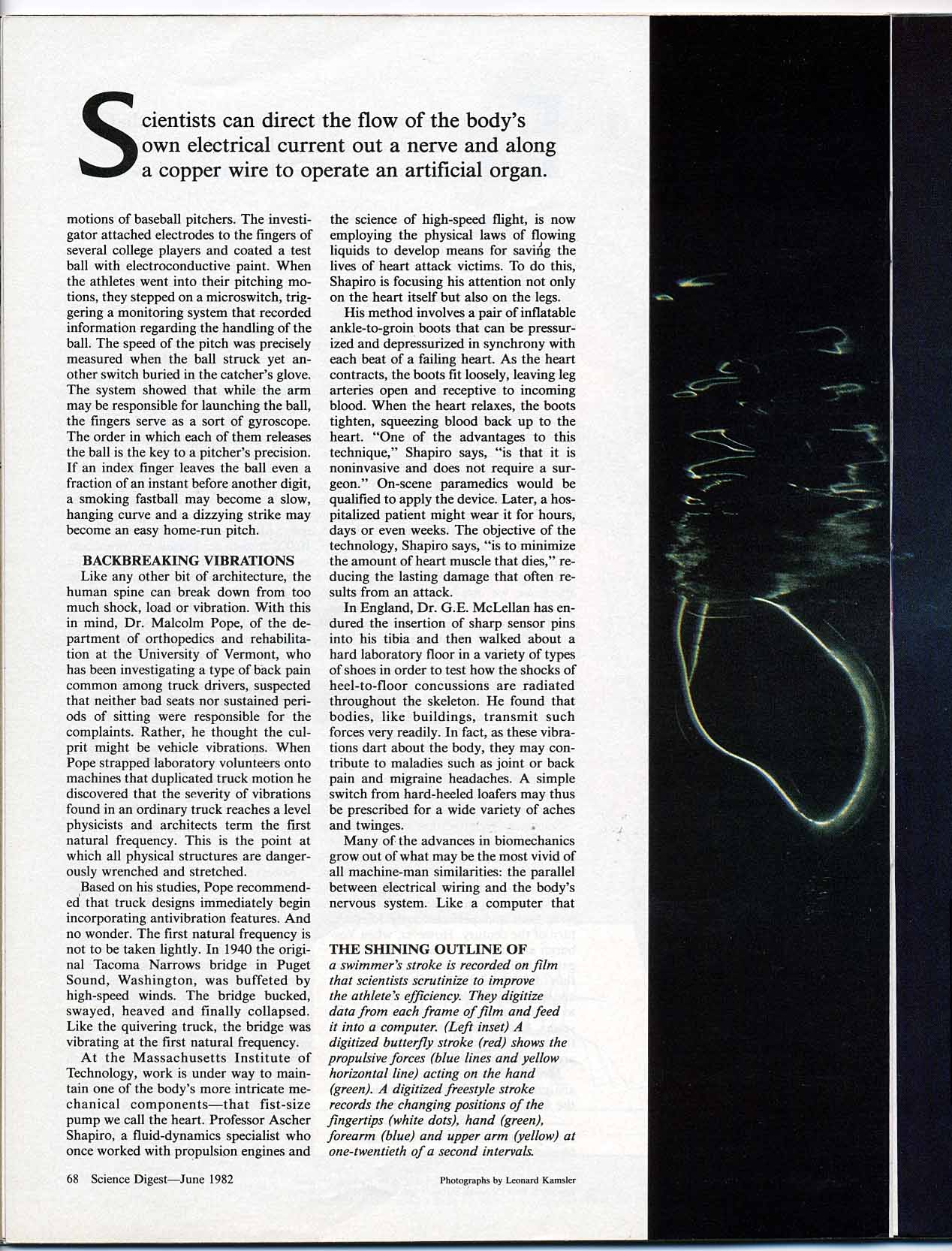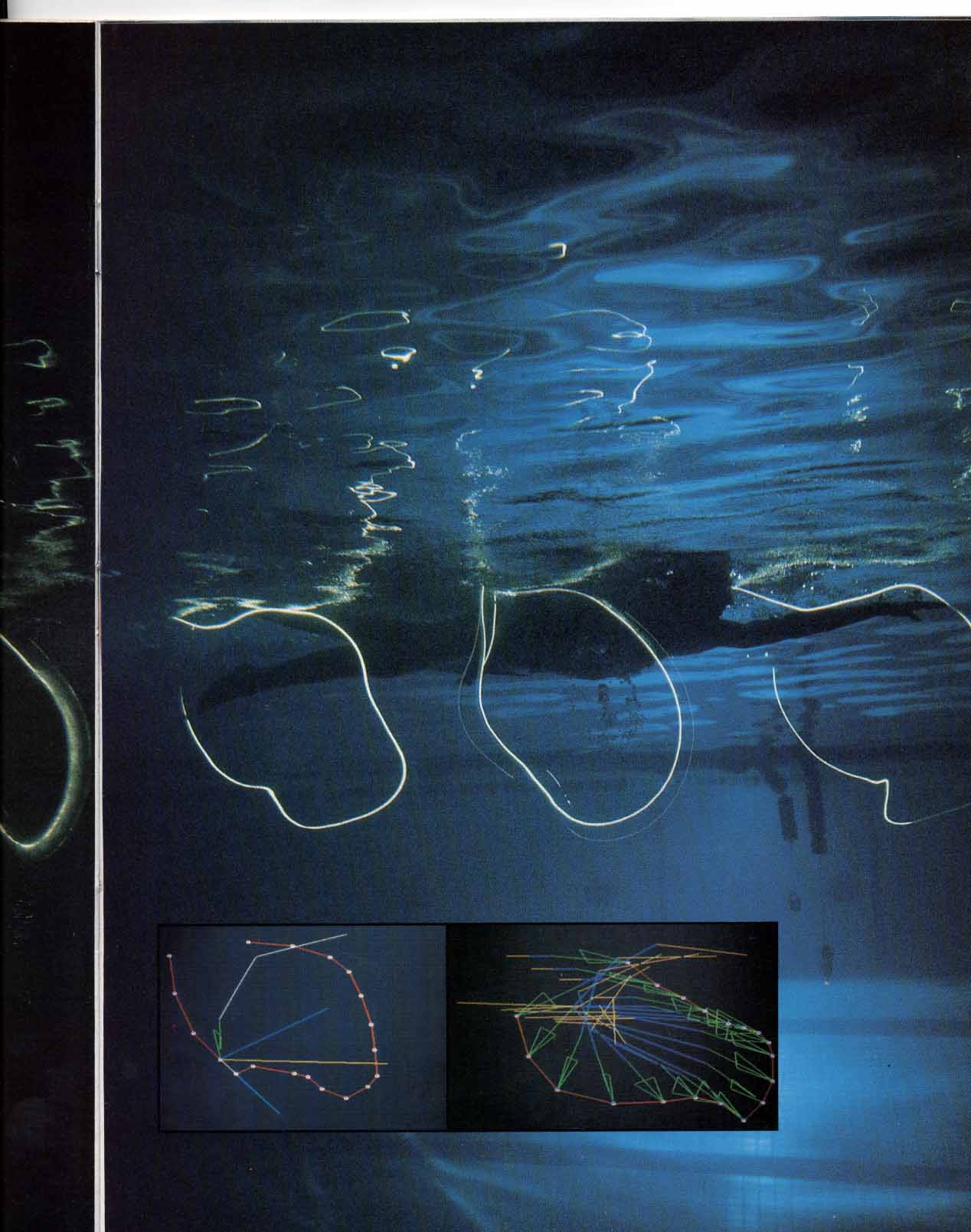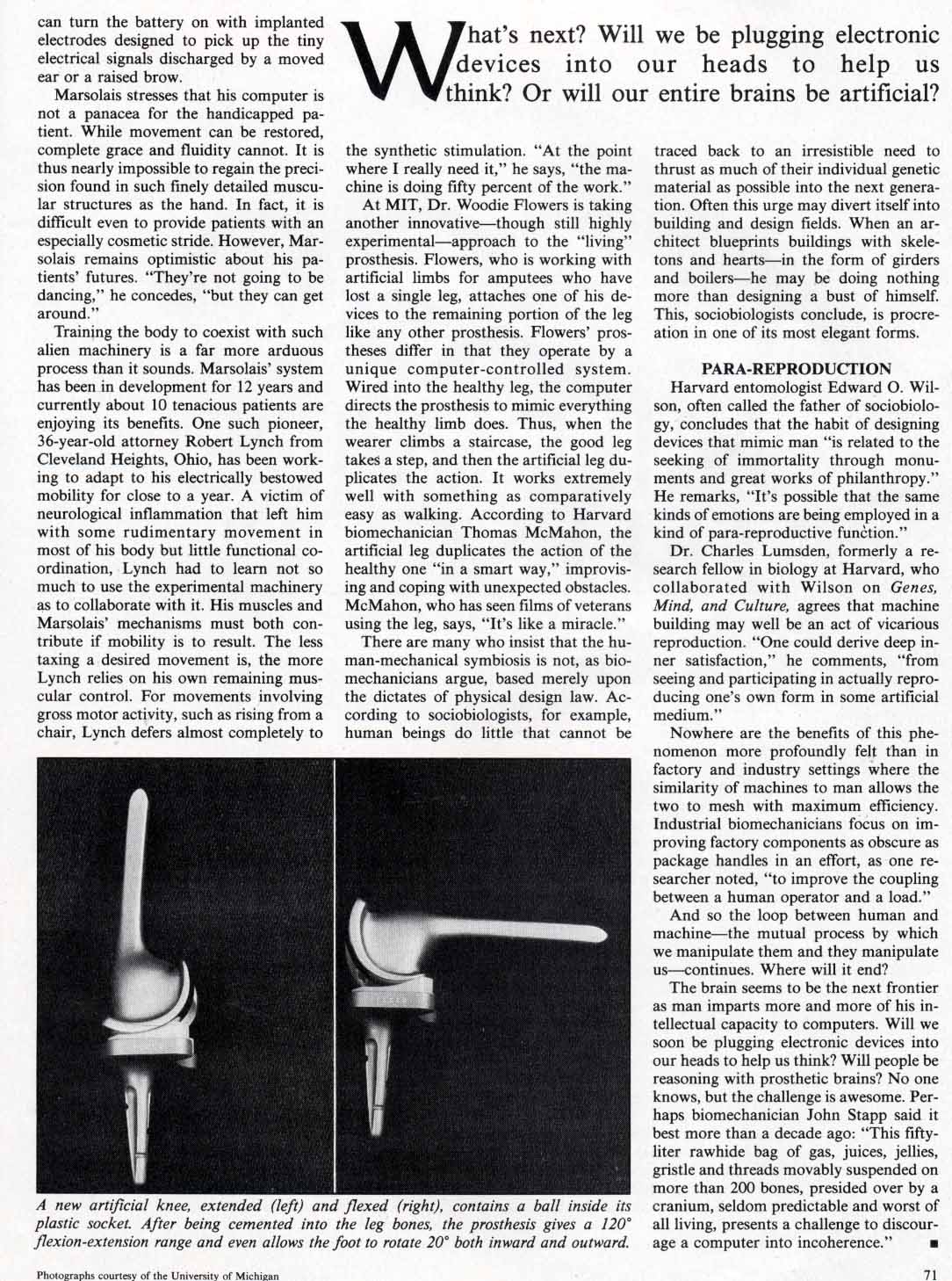The Human Machine
Computers analyze a swimmer's stroke; special boots pump a weak heart; electricity helps the paralyzed walk again. A new science is creating The Human Machine.
By Jeffrey Kluger in Science Digest on Tuesday, June 1, 1982
The article titled "The Human Machine" discusses the emerging field of biomechanics, which applies engineering principles to the human body. The article highlights various applications of biomechanics in healthcare, sports, and other fields. For instance, artificial body parts like knees are being developed using engineering principles. Biomechanics is also being used to improve athletic performance, with scientists using computerized footwear and high-speed films to analyze and enhance athletes' movements. The article also discusses the use of biomechanics in studying the effects of vehicle vibrations on truck drivers and the development of inflatable boots to aid heart attack victims. The article concludes by discussing the potential of using the body's natural electrical network to control artificial organs and limbs.
The article discusses the work of biomechanician Ernest Byron Marsolais, who has developed a computer system that can stimulate muscle movement in patients with limited mobility. The system, which is currently the size of a small refrigerator, uses a nine-volt battery to send electrical signals to the muscles, causing them to contract. This has allowed some patients who were previously confined to wheelchairs to walk, and others who had no use of their arms to grasp objects. The system can be tailored to the needs of individual patients, and can be activated using a variety of methods, including a hand-controlled microswitch or implanted electrodes. The article also discusses the work of Dr. Woodie Flowers at MIT, who is developing a computer-controlled prosthesis for amputees. The prosthesis mimics the movements of the patient's healthy limb, allowing them to walk and climb stairs more easily. The article concludes by discussing the potential future of biomechanics, including the possibility of using electronic devices to enhance cognitive function.
Tip: use the left and right arrow keys
Computers analyze a swimmer's stroke; special boots pump a weak heart; electricity helps the paralyzed walk again. A new science is creating
The Human Machine
Sprinting gracefully downfield, a football player closes in confidently on a sure touchdown. But just short of the goal line, his rhythm breaks and in a grimace of agony he tumbles forward. His Achilles tendon, the stout cord at the back of his ankle, has ruptured, and his foot hangs limply as he is helped off the field. Across town, a construction derrick strains to lift an enormous steel girder. Struggling against too heavy a load, a cable snaps. The girder goes crashing to the sidewalk, and the derrick collapses. Each day, the gap narrows. Each day, the distinctions fade a bit more. The distance between man and machine-and the differences that make each unique-are vanishing. In function, design, intellect and even mortality, what we are and what we build grow ever more similar. It is a trend that's hardly new. For centuries we have endowed much of what we build with the attributes of living beings. Our cars are quadrupeds equipped with two eyelike orbs. Our power shovels and backhoes feature "arms" that bend and reach with striking similarity to our own. Complex webs of mains and pipes transport water through buildings, just as an even more intricate network of arteries, veins and capillaries carries blood through our bodies. Our language, too, reflects a blurring of the line between biology and engineering: our main roads are arteries; our corporate headquarters are nerve centers; our spaceships are covered with protective skins. We measure distances in feet, and we get to the heart of a matter. And despite our knowledge that living things die and inorganic objects don't, how often have we heard a motorist claim that his battery just did? The parallels between biology and machinery are so remarkable that human inventions and human beings may have passed the point of simple similarity. Rather, the two are slowly integrating, weaving into a single, inseparable unit, a human machine. Nowhere is the consolidation more evident than in health care. Take artificial body parts, for example. For centuries we have designed door hinges and machine joints that mimic the action of the knee. That same technology is now allowing us to replace the knee itself. At the Hospital for Special Surgery in New York City, doctors are working with engineers to build artifi
64 Science Digest-June 1982
Illustration by Don ivan Punchatz
FAST TRACK
Scientists are using engineering ideas not only to help runners move more efficiently but also to scrutinize the very track over which they labor.
Computer analyses done by Thomas McMahon, a professor of applied mechanics and biology at Harvard, and Peter Greene, a professor of bioengineering at Johns Hopkins, have revealed that the nature of a running surface can have a profound effect on athletic performance. According to McMahon, there is a "mechanical interaction between the runner and the track." The critical phase in an athlete's stride is the point at which the foot makes contact with the ground. A turf of the right composition will be compressed by this impact and then quickly rebound, literally bouncing the runner up and forward. The more resilient the surface, the greater the propulsion. McMahon and Greene therefore set out to create a track that would take maximum advantage of this springboard phenomenon.
How could a running surface be made to utilize springiness to best effect? Unleashing runners on a rubber field and sitting back contentedly while they race to set new records is not the answer; anyone who has taken two or three loping steps across a trampoline knows that there is a point at which a surface can become too pliant. What the researchers sought was a track that fell within a narrow range of speed-enhancing resiliency.
The result of their research-the "tuned track"was completed in 1978. Built of plywood with a polyurethane coating, the track was 20 times softer than conventional surfaces, which are typically concrete blanketed with a thin layer of polyurethane. The track was first installed at Harvard and resulted in a threeto five-second improvement in student performance in the mile run as well as a substantial reduction in injuries. By 1979. New York's Madison Square Garden had built its own tuned track. In the first meet held on the new surface, 13 events were run and 12 world, indoor or meet records were set.
To measure pressures on a foot, shoes are equipped with transducer mats that send signaLc to a computer. This readout shows force on the bull o/' the foot.
66 Science Digest-June 1982
A computer-generated figure running on foam pillows springs into a long stride.
Electrodes on a pitcher's fingers reveal that if one digit leaves the ball even an instant after another, a fastball becomes a slow curve.
cial knees to replace the diseased joints of patients with bone cancer or certain other ailments. During the transplant surgery, the doctors leave the patient's lower and upper leg untouched while they remove the afflicted area. They then cement the metallic substitute in place, retaining the body's own ligaments. Built of a cobaltchrome or titanium alloy and polyethylene, the implant owes its existence as much to engineering as it does to medicine.
LAWS OF MECHANICS
The new science of biomechanics is harvesting what we have learned in building structures from cars to cranes to spacecraft and turning this knowledge back into that most complex of contraptions-the human body. Biomechanical science approaches the body armed not with traditional medical concepts but with notions of torque, load, stress, lift and drag. From the view of the biomechanician, we owe our ability to move about and support ourselves chiefly to the everyday laws that govern fulcrums, levers, pulleys and counterweights.
Human beings and machines are both physical structures that, if they are going to function, must come to terms with the same physical laws, says Dr. Frederick Vosburgh, of Rockefeller University in New York City. "There is a correspondence between what we design and what nature has designed," he adds. "And the key to that correspondence is that there is a selection of what works and what doesn't work in both spheres."
Scientists often find that even the most obscure of man's inventions may turn out to be little more than hand-me-down tricks long ago mastered by nature. Braces designed to stabilize the fuselage against twisting in rockets and airplanes were built and perfected only after the turn of the century. However, when Vosburgh and his associates recently investigated the fibrous structure of sharkskin, they discovered that a shark's rear fins are held rigid in almost the same fashion as a fuselage. Aerodynamic laws, it seems, forced human engineers to reach the same conclusions nature did-we just arrived at our answers a bit later.
Jeffrey Kluger, assistant editor, observed hiomecha:ics in Nova Scotia and New York.
More and more, biomechanicians are analyzing human form and function with the same tools used to test inanimate devices and using what they find to help the human body work better. At California's Coto Research Center, biomechanician Gideon Ariel is employing sophisticated electronic systems to decipher and improve the performance of athletes.
Currently, Ariel is designing what may be the world's first computerized footwear-a running shoe with a microchip nestled in its sole. The chip operates as a pressure and load gauge, recording and interpreting foot impact and stride length. At the conclusion of an exercise period, the runner simply removes the device and plugs it into a home computer to learn his average speed, the distance he ran, the calories he burned and how much weight he is likely to lose.
Ariel is also one of several biomechanicians who have been using ultra-highspeed films, moving at the rate of up to 10,000 frames per second, to record acts as simple as walking or as complex as a basketball lay-up shot. He then projects the films onto a screen with a grid and thousands of coordinates. A computer can thus follow a specific spot on the volunteer's anatomy as it passes across the grid and assess how far, how fast, how efficiently and how expertly the subject's limb travels in a given instant. The device, which breaks movement and agility down into countless tiny fragments, helps distinguish previously indistinguishable elements of motion. So well does this unforgiving scrutiny work that Ariel has been asked to apply his techniques to members of several professional sports teams and even to athletes on the 1984 Olympic squad.
HYDRODYNAMICS
Robert Schleihauf, who is studying the biomechanics of swimming at Teachers College, Columbia University, has built models of the human hand, accurate down to the pores, and immersed them in tanks of moving water to test the hydrodynamic soundness of various hand positions, in the same fashion that propeller blades and airfoil sections of ships are routinely analyzed. Like Ariel, he also films athletes and has succeeded in breaking swimmers' stroke cycles down into intervals of one-fiftieth of a second. With such testing systems, he can help many athletes improve both their speed and efficiency of energy consumption.
Dr. Joan Stevenson, a biomechanician now at Queens University, Kingston, Canada, has studied the arm and finger
A hard surface reduces the figure's ground contact but shortens its stride.
Photograph by John C. Russell/Focus On Sports; top computer image courtesy of Peter Cavanagh; bottom images courtesy of Tom McMahon
67
Scientists can direct the flow of the body's own electrical current out a nerve and along a copper wire to operate an artificial organ.
motions of baseball pitchers. The investigator attached electrodes to the fingers of several college players and coated a test ball with electroconductive paint. When the athletes went into their pitching motions, they stepped on a microswitch, triggering a monitoring system that recorded information regarding the handling of the ball. The speed of the pitch was precisely measured when the ball struck yet another switch buried in the catcher's glove. The system showed that while the arm may be responsible for launching the ball, the fingers serve as a sort of gyroscope. The order in which each of them releases the ball is the key to a pitcher's precision. If an index finger leaves the ball even a fraction of an instant before another digit, a smoking fastball may become a slow, hanging curve and a dizzying strike may become an easy home-run pitch.
BACKBREAKING VIBRATIONS
Like any other bit of architecture, the human spine can break down from too much shock, load or vibration. With this in mind, Dr. Malcolm Pope, of the department of orthopedics and rehabilitation at the University of Vermont, who has been investigating a type of back pain common among truck drivers, suspected that neither bad seats nor sustained periods of sitting were responsible for the complaints. Rather, he thought the culprit might be vehicle vibrations. When Pope strapped laboratory volunteers onto machines that duplicated truck motion he discovered that the severity of vibrations found in an ordinary truck reaches a level physicists and architects term the first natural frequency. This is the point at which all physical structures are dangerously wrenched and stretched.
Based on his studies, Pope recommended that truck designs immediately begin incorporating antivibration features. And no wonder. The first natural frequency is not to be taken lightly. In 1940 the original Tacoma Narrows bridge in Puget Sound, Washington, was buffeted by high-speed winds. The bridge bucked, swayed, heaved and finally collapsed. Like the quivering truck, the bridge was vibrating at the first natural frequency.
At the Massachusetts Institute of Technology, work is under way to maintain one of the body's more intricate mechanical components-that fist-size pump we call the heart. Professor Ascher Shapiro, a fluid-dynamics specialist who once worked with propulsion engines and the science of high-speed flight, is now employing the physical laws of flowing liquids to develop means for saving the lives of heart attack victims. To do this, Shapiro is focusing his attention not only on the heart itself but also on the legs.
68 Science Digest-June 1982
His method involves a pair of inflatable ankle-to-groin boots that can be pressurized and depressurized in synchrony with each beat of a failing heart. As the heart contracts, the boots fit loosely, leaving leg arteries open and receptive to incoming blood. When the heart relaxes, the boots tighten, squeezing blood back up to the heart. "One of the advantages to this technique," Shapiro says, "is that it is noninvasive and does not require a surgeon." On-scene paramedics would be qualified to apply the device. Later, a hospitalized patient might wear it for hours, days or even weeks. The objective of the technology, Shapiro says, "is to minimize the amount of heart muscle that dies," reducing the lasting damage that often results from an attack.
In England, Dr. G.E. McLellan has endured the insertion of sharp sensor pins into his tibia and then walked about a hard laboratory floor in a variety of types of shoes in order to test how the shocks of heel-to-floor concussions are radiated throughout the skeleton. He found that bodies, like buildings, transmit such forces very readily. In fact, as these vibrations dart about the body, they may contribute to maladies such as joint or back pain and migraine headaches. A simple switch from hard-heeled loafers may thus be prescribed for a wide variety of aches and twinges.
Many of the advances in biomechanics grow out of what may be the most vivid of all machine-man similarities: the parallel between electrical wiring and the body's nervous system. Like a computer that
THE SHINING OUTLINE OF
a swimmer's stroke is recorded on film that scientists scrutinize to improve the athlete's efficiency. They digitize data from each frame of film and feed it into a computer. (Left inset) A digitized butterfly stroke (red) shows the propulsive forces (blue lines and yellow horizontal line) acting on the hand (green). A digitized freestyle stroke records the changing positions of the fingertips (white dots), hand (green), forearm (blue) and upper arm (yellow) at one-twentieth of a second intervals.
Photographs by Leonard Kamsler
BRAIN BOOSTERS
Now that scientists are linking human minds with machines, the power of thought can be put to work.
Mind-reading machines may be here sooner than you think. Researchers are beginning to recognize distinct brain-wave patterns that can trigger a receptive instrument.
The military is especially interested in biocybernetics, the linkage of human operator and machine. The Defense Advanced Research Projects Agency (DARPA) recently funded a study led by Dr. Lawrence Pinneo at SRI International. Some subjects learned to move white dots on a TV screen by silently mouthing the words up or down. Electrodes attached to their scalps picked up changes in electrical voltages produced by tiring neurons. This information was translated into brain-wave patterns by an electroencephalograph. A computer moved the dots according to the different wave shapes.
Machines that can pick up brain signals might be used to identify human errors not consciously recognized by the erring person. In one study, Drs. Emanuel Donchin, Gregory McCarthy and Marta Kutas of the University of Illinois observed brain waves emitted during split-second responses to tasks that required information processing. Subjects faced with a long list of female names and a short list of male ones were told to quickly classify the names as male, female or neutral. A P-300 brain wave, which occurs after a surprising and relevant event, appeared alter each decision was made. But Donchin found that when the decision was wrong, the P300 was often delayed by 200 to 300 milliseconds. If a machine noticed this delay, it could notify an individual of an error even before he became aware of it. Or the system might sense a machine operator nodding and signal not to ship that batch of the product.
Air Force researchers, concerned with data overload suffered by air traffic controllers, are monitoring brain waves while subjects watch the comings and goings of randomly arranged blips on radar screens. When there is no indication that a test subject has noticed an event, even though it has registered in his brain, the monitoring machine signals him to pay attention.
Theoretically, says Dr. Charles Rebert, of SRI International, even a simple monitoring of general states of awareness could be helpful. For example, pilots undergoing high G forces at speeds faster than sound, and close to losing consciousness, could be relieved by an automatic switchover to machine control.
The logical extension of the work already being done on the link between mind and machine, according to Dr. Glenn Cartwright of Computer-based Instructional Research Lab at McGill University in Montreal, is the direct electronic transmission of thought from brain to brain. He predicts that "electronic telepathy" will become a reality early in the next century. "The idea is no more incredible than had I suggested a hundred years ago that we were going to project human voices around the world." he says. This linking of human minds will, in effect, create one huge brain, with people sharing not only what they think but also what they know. Someday. a tiny microprocessor implanted in the brain may be able to hook into a computerized data bank. Simply think a question and it will be answered. This chip need not be an electronic foreign body; EMV Associates in Rockville. Maryland, is developing protein components that could be used to make an organic chip.
Some researchers dismiss these ideas as science fiction. Dr. Cartwright says they are "science projection." He believes we are entering a world in which the human brain will help us make the most of the senses we now have and activate some-such as an ability to detect dangerous levels of radioactivity-that we have only imagined.
-Geraldine Youcha
feeds its orders out through cables and across junctions, the brain transmits its commands via low-level electrochemical charges that course through miles of nerve fibers to every organ in the body. By tapping into this natural electronics network, scientists can detour bodily current and direct its flow out of a nerve, through a copper wire and to an artificial organ.
At the UCLA Medical Center, researchers in an experimental program have developed a method for wiring a muscle in an amputee's stump to a synthetic hand that features such details as cosmetic veins and fingernails. The wire carries the muscular current into the prosthesis, where it activates a sensitive motor and the hand opens and closes on command. To be sure, the agility of the prosthesis is limited; however. the device does show that an order originating in an organic brain can culminate in the functional movement of an inorganic collection of plastics, gears and electronic circuits.
All such systems are designed for patients who have damaged or absent limbs but retain healthy nervous systems. However, what of paralysis victims with damaged spinal cords who can no longer command muscles to move because the neural links between their brain and limbs have been severed? The problem is like trying to turn on a lamp whose cord has been cut. It is also a problem that may at last have a solution. Biomechanician Ernest Byron Marsolais of Ohio's Case Western Reserve University, working at the Cleveland Veterans Administration Hospital, inserts unobtrusive needles into patients' limbs, wires the probes to a computer and hooks the computer to a simple nine-volt battery. The battery supplies the current that the computer applies to the body in a smooth, natural sequence. As the various muscles receive their patterned stimulation, they gracefully contract and the limbs begin to stir. Some people who have been confined to wheelchairs can walk after training. Some people who had no use of their arms are able to grasp.
SUPER-SUBTLE CONTROL
Marsolais' computer, while currently the size of a small refrigerator, will, if VA funding continues, soon be reduced so that it can be worn comfortably on the body. Most encouragingly, the entire system can be tailored to fit the needs of the individual patient. A person handicapped only from the waist down can turn the system on with a hand-controlled microswitch. A quadriplegic without the use of his hands but with some shoulder mobility can use his upper arm to press a switch attached to his upper chest. Even people with no movement at all below the neck
70 Science Digest-June 1982
can turn the battery on with implanted electrodes designed to pick up the tiny electrical signals discharged by a moved ear or a raised brow.
Marsolais stresses that his computer is not a panacea for the handicapped patient. While movement can be restored, complete grace and fluidity cannot. It is thus nearly impossible to regain the precision found in such finely detailed muscular structures as the hand. In fact, it is difficult even to provide patients with an especially cosmetic stride. However, Marsolais remains optimistic about his patients' futures. "They're not going to be dancing," he concedes, "but they can get around."
Training the body to coexist with such alien machinery is a far more arduous process than it sounds. Marsolais' system has been in development for 12 years and currently about 10 tenacious patients are enjoying its benefits. One such pioneer, 36-year-old attorney Robert Lynch from Cleveland Heights, Ohio, has been working to adapt to his electrically bestowed mobility for close to a year. A victim of neurological inflammation that left him with some rudimentary movement in most of his body but little functional coordination, Lynch had to learn not so much to use the experimental machinery as to collaborate with it. His muscles and Marsolais' mechanisms must both contribute if mobility is to result. The less taxing a desired movement is, the more Lynch relies on his own remaining muscular control. For movements involving gross motor activity, such as rising from a chair, Lynch defers almost completely to the synthetic stimulation. "At the point where I really need it," he says, "the machine is doing fifty percent of the work."
At MIT, Dr. Woodie Flowers is taking another innovative-though still highly experimental-approach to the "living" prosthesis. Flowers, who is working with artificial limbs for amputees who have lost a single leg, attaches one of his devices to the remaining portion of the leg like any other prosthesis. Flowers' prostheses differ in that they operate by a unique computer-controlled system. Wired into the healthy leg, the computer directs the prosthesis to mimic everything the healthy limb does. Thus, when the wearer climbs a staircase, the good leg takes a step, and then the artificial leg duplicates the action. It works extremely well with something as comparatively easy as walking. According to Harvard biomechanician Thomas McMahon, the artificial leg duplicates the action of the healthy one "in a smart way," improvising and coping with unexpected obstacles. McMahon, who has seen films of veterans using the leg, says, "It's like a miracle."
There are many who insist that the human-mechanical symbiosis is not, as biomechanicians argue, based merely upon the dictates of physical design law. According to sociobiologists, for example, human beings do little that cannot be traced back to an irresistible need to thrust as much of their individual genetic material as possible into the next generation. Often this urge may divert itself into building and design fields. When an architect blueprints buildings with skeletons and hearts-in the form of girders and boilers-he may be doing nothing more than designing a bust of himself. This, sociobiologists conclude, is procreation in one of its most elegant forms.
PARA-REPRODUCTION
Harvard entomologist Edward O. Wilson, often called the father of sociobiology, concludes that the habit of designing devices that mimic man "is related to the seeking of immortality through monuments and great works of philanthropy." He remarks, "It's possible that the same kinds of emotions are being employed in a kind of para-reproductive function."
Dr. Charles Lumsden. formerly a research fellow in biology at Harvard, who collaborated with Wilson on Genes, Mind, and Culture, agrees that machine building may well be an act of vicarious reproduction. "One could derive deep inner satisfaction," he comments, "from seeing and participating in actually reproducing one's own form in some artificial medium."
Nowhere are the benefits of this phenomenon more profoundly felt than in factory and industry settings where the similarity of machines to man allows the two to mesh with maximum efficiency. Industrial biomechanicians focus on improving factory components as obscure as package handles in an effort, as one researcher noted, "to improve the coupling between a human operator and a load."
And so the loop between human and machine-the mutual process by which we manipulate them and they manipulate us-continues. Where will it end?
The brain seems to be the next frontier as man imparts more and more of his intellectual capacity to computers. Will we soon be plugging electronic devices into our heads to help us think? Will people be reasoning with prosthetic brains? No one knows, but the challenge is awesome. Perhaps biomechanician John Stapp said it best more than a decade ago: "This fiftyliter rawhide bag of gas, juices, jellies, gristle and threads movably suspended on more than 200 bones, presided over by a cranium, seldom predictable and worst of all living, presents a challenge to discourage a computer into incoherence."
hat's next? Will we be plugging electronic devices into our heads to help us think? Or will our entire brains be artificial?
A new artificial knee, extended (left) and flexed (right), contains a ball inside its plastic socket. After being cemented into the leg bones, the prosthesis gives a 120� flexion-extension range and even allows the foot to rotate 20� both inward and outward.
Photographs courtesy of the University of Michigan
71

